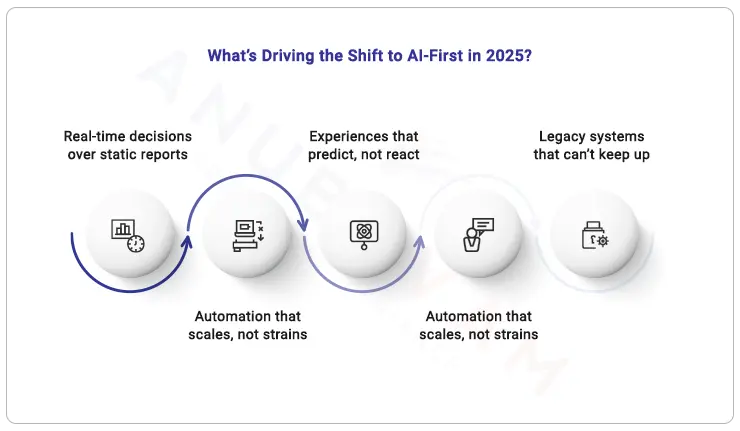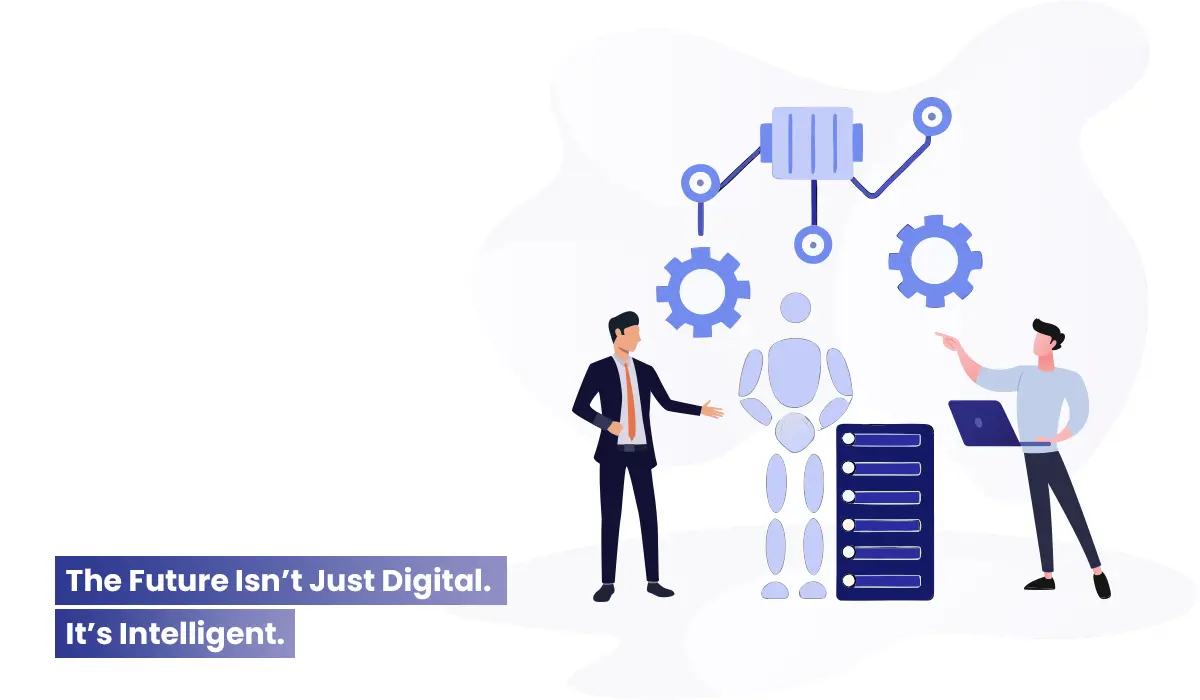Introduction: Digital No Longer Means Enough
What is AI transformation, and how is it redefining digital transformation in 2025?
In 2025, enterprise leaders aren’t asking, “Are we digital?” they’re asking, “Where isn’t AI already optimizing this?”
That’s because digital transformation on its own has plateaued. You can only digitize so many workflows before you hit the limits of manual logic, flat data, and disconnected tools. The change from digitization to AI transformation now sets forward-thinking businesses apart. This is a model where platforms think, adapt, and act without waiting for a person to tell them to.
IDC says that by 2025, 60% of global businesses will have formal AI governance plans in place. These will include intelligence in all workflows, from analytics to compliance to customer experience.
But AI transformation isn’t just a tech upgrade. It’s a new operating model where decisions are predictive, systems are self-improving, and automation is no longer siloed.
This blog breaks down what that shift really means and how enterprise leaders can move from digital-first to AI-first in a world where “smart” is the new standard.
Key Takeaways
If you’re a CTO, COO, CEO, or enterprise strategy leader making decisions about the future of your operating model, this is what matters:
Digital maturity is no longer a differentiator; AI transformation is.
- Intelligent systems now guide workflows, not just automate them.
- The AI-first mindset replaces static dashboards with adaptive decisions.
- Enterprises designed around an AI-powered strategy move faster and scale smarter.
- Leaders who embrace predictive, self-learning systems gain a clear edge.
This blog breaks down how to move from digital transformation to intelligent transformation and why it’s your next real advantage.
From Digitization to Intelligence
How has digital transformation evolved in 2025?
Digitization got us online. AI is what gets us ahead.
Digital transformation used to entail automating, moving, and going paperless. In 2025, that's the baseline, not the advantage.
Leading companies can sense, predict, and act in real time across all processes.
That transition has led to intelligent automation, AI-driven decision-making, and platforms that learn from every input.
Enterprises that stay digital-only fall behind. Those that build AI-first models move faster, adapt quicker, and operate with intelligence at the core.
Core Drivers of AI Transformation
What’s fuelling the rise of AI transformation in enterprises?
AI transformation isn’t a tech trend; it’s a business response to pressure.

In short: complexity has outpaced manual logic. Only AI can keep up.
Use Cases: Where AI is Already Transforming Work
How are industries applying AI in real workflows?
AI is already in the room, not on the roadmap. The most innovative industries are building around AI, not experimenting with it.
Here’s how real workflows are being reimagined:
- Education: AI-assisted audit logic drives curriculum alignment, OBE/OBL mapping, and automated accreditation reporting in education.
- Healthcare: AI helps doctors make accurate diagnoses and plan treatment plans by predicting what each patient will need.
- Finance: Smart credit scoring and real-time fraud spotting lower risk without slowing down approvals.
- HR: Screening with AI and predictive attrition reports helps improve talent pipelines.
In regulated businesses, AI has cut the time it takes to do things by hand by up to 70%, according to Deloitte Report, 2023.
AI Maturity and the New Operating Model
What does an AI-first enterprise look like in 2025?
AI-first enterprises aren’t just using AI they’re designed around it.
Unlike digital-first orgs that rely on fragmented automation, AI-first businesses operate with a connected, intelligent core. The shift is architectural, not cosmetic.
Key traits of an AI-mature operating model include:
- Decisions enhanced by AI copilots and predictive models are not delayed by dashboards
- Orchestration across departments, where workflows learn and adapt continuously
- Embedded governance and ethical AI use, not post-hoc compliance patches
- Integrated insights across business functions, finance, operations, customer, and compliance
McKinsey reports that AI-first organizations see up to 2× faster go-to-market velocity and 25–50% cost optimization across enterprise ops.
By 2025, enterprise maturity won’t be defined by how many tools you’ve digitized, but by how intelligently they work together.
But strategy doesn’t scale without leadership.
Leadership in the Age of AI
How should business leaders approach AI transformation?
AI transformation isn't just a tech choice; it's a change in how leaders work.
For today's leaders, success isn't about knowing how AI works; it's about knowing how to lead systems that do.
This is how leaders who are ready for AI think differently:
- Instead of digitizing workflows, they rethink intelligence.
- They assess impact by decision speed, not headcount.
- Strategic infrastructure includes AI governance and data openness.
With cross-functional fluency, product, IT, and compliance speak the same operational language.
According to the Harvard Business Review (2024), leaders who put AI first say that executive decisions are made 40% faster and there are a lot less data silos.
In short: the most effective leaders aren’t just approving AI projects. They’re designing AI-native organizations.
The Future Isn’t Digital; It’s Intelligent
What’s next for businesses embracing AI transformation?
Digital maturity is no longer a goal—it’s the ground floor. The next frontier is intelligence by design.
In AI-transformed enterprises, systems don’t just automate tasks. They guide decisions. They learn. They anticipate. And they adapt faster than your next board meeting.
What’s coming next?
- Platforms that self-optimize every workflow
- Dashboards that predict before reporting
- Operating models that scale with less manual friction
Enterprises that succeed in 2025 won’t be the most digitized. They’ll be the most intelligent.
Ready to Make the Shift from Digital to AI-First?
You’ve digitized. Now it’s time to lead with intelligence. Book a Strategy Session with Our Anuabavam Transformation Team.
Let’s help you move faster with systems that think with you.
Related Articles
AI for Healthcare Compliance: 7 Ways Hospitals Automate HIPAA, GDPR, and Regional Regulations
Tune In To Our Audio Blog Introduction: Why AI Matters for Healthcare Compliance Today Healthcare leaders will tell you the same truth: compliance work has grown faster than the sy…
Read More →How AI Reduces Dropouts in Digital Learning
Tune In To Our Audio Blog Introduction: How AI Helps Prevent Student Dropouts Digital learning has opened the door to access, flexibility, and scale. Yet it has also magnified an o…
Read More →7 Ways AI Improves Data Quality, Lineage, and Trust Across the Enterprise
Tune In To Our Audio Blog Introduction For AI transformation to work, the data it uses must be correct, full, and reliable. But most businesses still have problems with data that i…
Read More →Subscribe to the Creatrix Blog
Fresh insights on higher education, straight to your inbox.
We respect your privacy.
Want to contribute?
We welcome thought leaders to share ideas and write for our blog.
Become a Guest Author →

